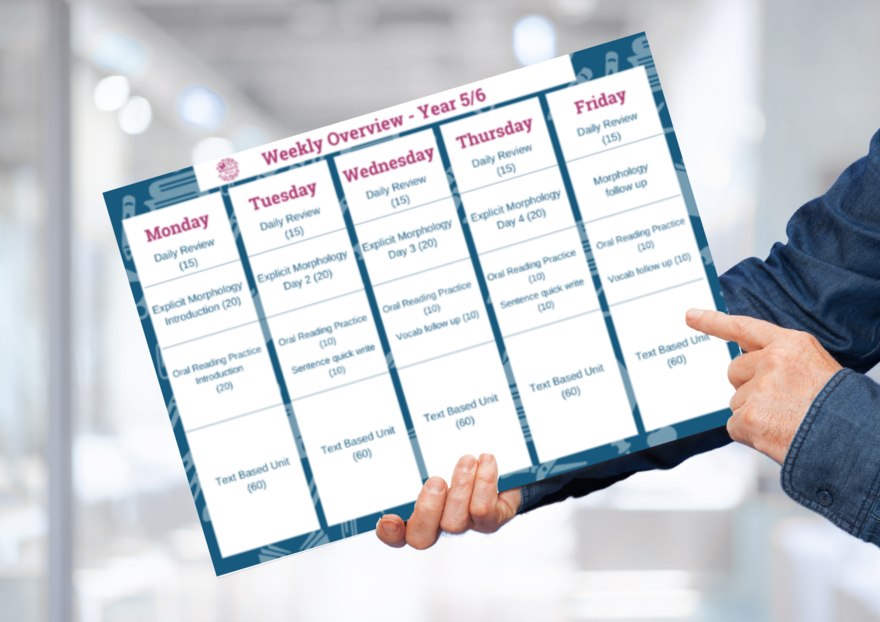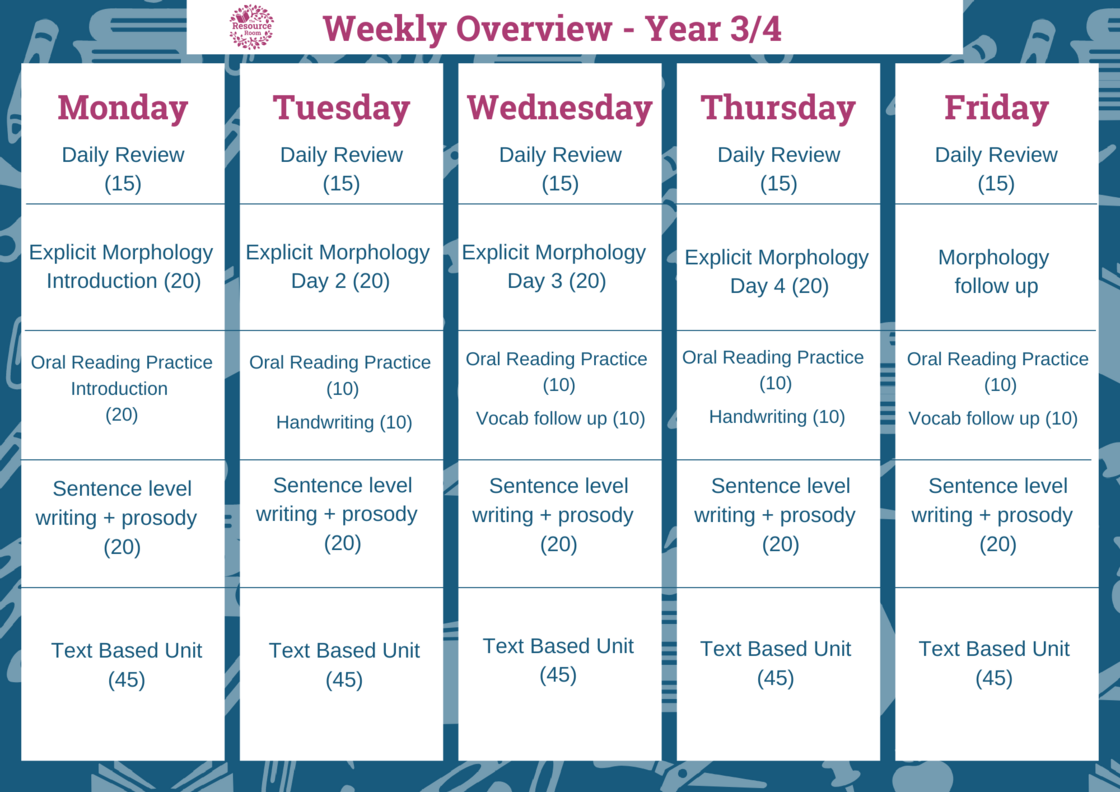S1 E8 - What goes into the Upper Primary Literacy Block?

Transcript Summary
For a very long time, we have focused exclusively on what goes into the early years literacy block and upper primary teachers, it is your turn. One of the questions in the Facebook group and other places is: exactly what should my literacy block look like in years three to six? And I have to say that finding the perfect literacy block can feel like chasing a magical unicorn through an enchanted forest so that you can make a wish. We fervently hope that we will succeed and that all of our problems will be solved when we achieve this goal. But the reality is that when it comes to literacy blocks, perfection is as achievable as finding that unicorn.
But never fear. That doesn't mean that all is lost and whether you are teaching early years or upper primary, there are absolutely guidelines around what to include to make sure that we are hitting all of the important points so that we can help move the needle on student outcomes.
To find a checklist of what we need to teach, we need to look no further than the Language Literacy Network from Learning by Design. This infographic has the strands of Scarborough's reading rope represented on the left with the same elements on the right related to writing. And the important contribution that this makes to our understanding is that we are building one central body of knowledge that we apply through both a reading and writing lens.

Wasowicz, J. (2021) The Language Literacy Network. Learning By Design, Inc. www.learningbydesign.com
We are really used to thinking of our literacy block as being divided up into reading time and writing time. But a more useful perspective is to divide our time into top of the rope time and bottom of the rope time.
The top of the network is really around the language features and structures and the elements of text, and the bottom of the network is around the nuts and bolts. It's the decoding, encoding and the automaticity that comes with repeated practice at word level.
In the upper primary, our ideal scenario is that our time is spent refining and developing the top of the rope for both reading and writing. We're enhancing knowledge and skills in vocabulary, language structures, verbal reasoning, pragmatics and literacy knowledge. And, of course, we are building background knowledge to use as we read and write. But I have to say that a focus on these top strands doesn't mean that everything is only ever done in context. Every new thing we teach needs to be taught following an explicit teaching model where we build the field, and make sure children are gently led into understanding what we are doing so that they can come along on the journey. We model and deconstruct, engage in joint construction, and provide the opportunity for supported practice. Not just in one lesson, but across as many lessons as it takes for students to develop fluency and sound understanding of all of the concepts that we are teaching.
For most skills and areas of knowledge, it's a good idea to break them down into small parts and then increase the context in which the students work as fluency and automaticity develop. An example of this is syntax. As we introduce a new element, we teach it on its own before combining it with other things, and eventually expect the children to use these concepts in paragraphs and texts that they write themselves.
In The Resource Room, we have planning and assessment sections, and there are plans there with outlines of what your block might look like, guiding you into some of the decisions that you need to make. You can see an example below.


We need to include some sort of word work. Now, in the early years, this will be our phonics and decoding lesson, but in upper primary, this focus switches usually to a spelling approach. Now, for me, this is where morphology comes in. So a morphology-based approach to spelling is highly effective. It also has great evidence around its impact on students who are struggling readers. So talk about bang for our buck, we're going to extend our students to understand how words work every single student, and we're also going to positively impact our students who may need a little bit of extra help. And again, inside the resource room, we have lessons ready to go there for you that are taught across a four-day sequence with a gradual release model. We teach a morpheme, then we put it into a sentence orally just to talk about. We look at its role, in connecting with parts of speech. This is not something done in isolation. We look at parts of speech in sentences. We read words, we break words apart. We put words back together, and we read texts containing those target morphemes, and those are all in The Resource Room, ready to go for you.
The other elements of the upper primary literacy block include:
- Sentence Level Work
- Handwriting
- Repeated Oral Reading
- Text based units to teach reading comprehension and writing
I want to leave you with this thought; wrapping your head around a structured literacy block is less about being able to make a plan on paper than it is around feeling confident and fluent with the teaching routines and structures of explicit teaching. You won't become fluent without practice. You won't develop confidence without taking action and seeing things come together with your own eyes. You won't be perfect the first time you teach a morphology-based spelling lesson or the second time you stand at the front and guide students through a complex text. You won't even be perfect in this the third time or the fourth time. But you also won't break the children as you develop this fluency and proficiency in teaching this way.
Find things that support you. If that's from the Resource Room, that's awesome. If it's not, that is awesome as well. The goal is that you are all supported to teach children to read and write well all the way through school. So wherever you find the tools to do that, if that's serving your purpose, if it's doing what it needs to, then that's great. Please remember that something, evidence-informed, done imperfectly, will always be better for children than something not evidence-informed, done with full fidelity,
Don't try and do everything at once, just take it step by step.
If it were me, I'd start with a daily review and that morphology-based spelling work, because that's taught with low variance every week. Get confident with that, and then move into that text-based work and the explicit teaching around syntax. Whatever step you are up to in this, I want to say happy teaching everyone. The fact that you're listening to this podcast means that you are on the road already, and all will be well.
See you next episode.
Are you looking for tools, training and support to make strengthen your teaching in structured literacy? Then the Resource Room might be for you. Read more here or by clicking the image below.

 Jocelyn Seamer Education
Jocelyn Seamer Education
7 comments
I am really inspired by your podcasts Jocelyn and hope to become proficient in teaching structured literacy at every level in the Primary School.
Hi Alison. I am so pleased that you are finding the podcast to be useful. There is more to come!
Hi,
I have recently moved from Year 3 to Year 5. I have been looking into Emina McLean's English text unit, and her examples of storm bou. I'm not sure if you have seen it, but is that an example of text based unit?
Or do you mean a mentor text like a picture story book aligned with the hassle, science or health unit?
Thanks
Thank you for this. Super helpful podcast. Very interested in accessing the resource room - is it expensive to join?
Hi Jenna. You can sign up for a $2 trial and have a look around for a week. Then if you decide to stay joined up, just don't do anything and you'll be charged $15 per month or can choose a yearly membership for a discount.
I love the units and am looking forward to using them. They are all narratives though. Is there a reason for this? Is there a unit based on a nonfiction text?
Leave a comment